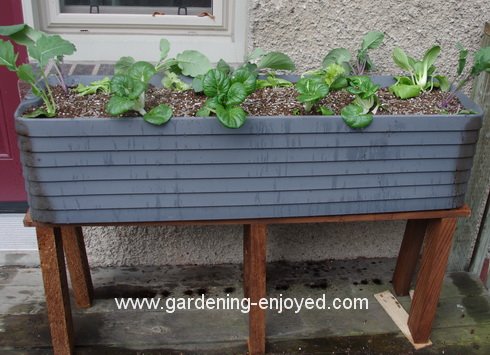
A few issues back I showed you a new planter that I was given to try. It was a large decorative subirrigation planter, aka self watering, a term I have a problem with, it features a new internal design to get the water from the reservoir to the plants. It came from Crescent Gardens a manufacturer of a rather high end line of gorgeous planters. This week it was time to plant it. Being me, I decided to make it a mini veggie garden and place it right outside my door. It’s probably a bit over planted but I wanted to see just what it could do. Pak Choi, Kohl Rabi, Lettuce, Broccoli and a couple of other plants were tucked along the perimeter of this planter. Then, going “slightly” overboard I sowed some Carrot and Beet seeds right down the centre. The structure of this planter has the deepest soil in the middle thus the attempt to grow root vegetables. Keep reading all season as we follow
the success or ?? of this trial. I’m always up for something new and interesting.
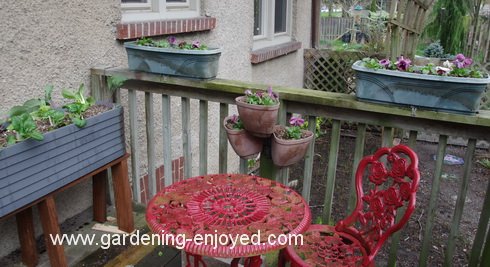
This is the side deck of the house that we use as the main entrance. There’s the new planter close to the door and the railing around the deck has five rather old planters that are currently filled with Pansies. The Begonias and Impatiens that are under the lights in the basement will eventually take their place when the summer heat slows them down. The interesting part of this picture is the stain that you can see on the side of the planters and it is also on the back and ends of the new one. Squirrels, aka bushy tailed tree rats, love to dig in the soft new soil of these planters, throwing little plants in all directions. Covering them with chicken wire sort of helps but it is tricky to get in place and the little %*&%$^ have been known to move it. That stain is Plantskydd the most effective animal repellent I have used. Not wanting it directly on my vegetables, I have taken to spraying it on the containers and then loosely
sprinkling Acti-Sol on the soil surface. It’s a great organic fertilizer, the odour of which repels squirrels. I also use it on the soil over freshly planted bulbs in the autumn. This combination of deterrents seems to work wonderfully and keeps the tree rats in the trees.
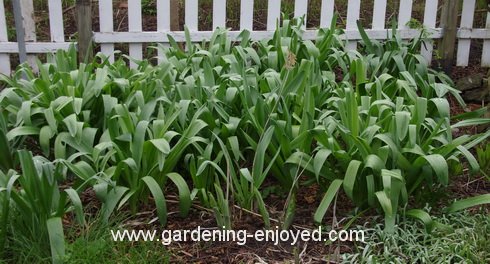
Amazing amount of growth in this picture, actually maybe a bit too much. This is the tall white flowered Allium, Mount Everest. Its bloom stalks are about 1.2 M tall with lovely large balls of pure white. Those white balls eventually turn green, at which point I start to cut them off as they are producing lots of fertile seeds. That mass of green is partly due to the bulbs multiplying but much more to seedlings that I’ve missed over the years. This year we must get busy and eliminate many of them. That’s difficult as pulling just gets the tops off and leaves the bulbs in the ground to come surging back next year. Although they are lovely for the week or so that they are in bloom that is actually my Hosta bed and they are out competing some of those Hosta. Interestingly they are both growing under the giant Black Walnut tree and are happy there.
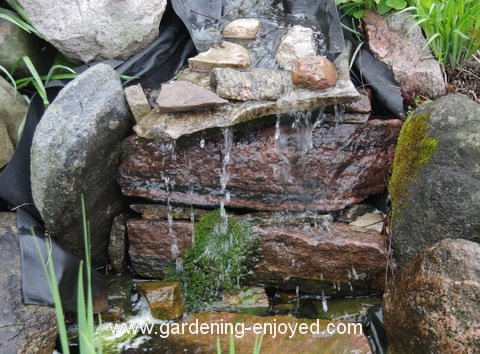
This spring I cleaned and refurbished the pump so that I could start the ponds and waterfalls running for the season. I was disturbed to find the water level in the ponds rapidly diminishing. Losing water is a regular problem with these ponds and searching out the leak is always a challenge. Some water will always disappear as the whole system acts as a giant evaporator and I’ve come to accept that. This was different. I suspected that a portion of the lower pond’s edge had sunken allowing the water to go out over it. Fixing that would have been a large job but having shut the pump off for a day or so and losing no water happily meant that was not the problem. The bottom waterfall was coming over in a narrow steady stream creating significant splash on the surrounding rocks, which then evaporated. Those smaller stones you can see in the stream just above the fall broke up that stream, greatly reducing the splash and mostly solving the problem. I do like my water
feature but it regularly turns me into an aquatic detective trying to figure out where the latest water loss is hiding.

My Rose collection seems to keep increasing although I’m not sure how. There’s always something new to try and a sample just arrives at my door. I must plant it. This picture is my hidden garden that you have to walk around behind the garage to appreciate. There now seems to be six Roses there, four of which are David Austins. I must admit to being partial to them although the new Canadian Roses, 49th Roses, from the Vineland Research Facility are also wonderful and are incredibly hardy and disease resistant. This year, with the very mild winter, they have all burst forth and are growing beautifully. I pruned them a little bit, mostly for shape and size and have given them their spring fertilizer. The fine folks at Acti-Sol now have a separate formulation just for Roses and I’m trying it. Can’t wait for those first glorious, fragrant
blooms.
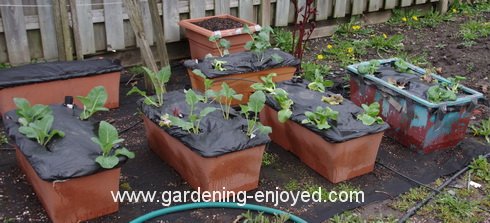
The subirrigation containers that I grow many of my vegetables in have been cleaned and setup and this past weekend we planted them, with all of the cool season vegetables. The cool weather was certainly here to test their tolerance but they all seem to be thriving and it won’t be too long before the first Pak Choi shows up on our dinner plates. The rapid growth of some of these early delights continues to amaze me particularly when the COOL season piece is emphasized as it has been lately.
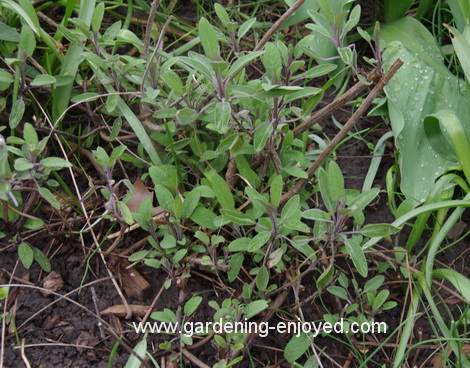 Sage is a wonderful herb just for its flavour and fragrance but the fact that it is reliably perennial makes it even more desirable. This picture shows my ever increasing clump of Sage. It has been cut back, almost to ground level and is now growing at a great clip. Even the process of cutting it back releases it’s rich aroma to remind us of grilled pork chops covered in chopped Sage.
Sage is a wonderful herb just for its flavour and fragrance but the fact that it is reliably perennial makes it even more desirable. This picture shows my ever increasing clump of Sage. It has been cut back, almost to ground level and is now growing at a great clip. Even the process of cutting it back releases it’s rich aroma to remind us of grilled pork chops covered in chopped Sage.
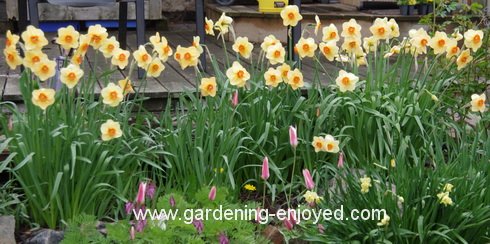
Narcissus are everywhere in the garden this spring and the cool weather is actually a bonus here as they are staying in bloom for weeks instead of days. This Narcissus altruist, a lovely small cup variety, is regularly one of the last to bloom. It was again this year but the early varieties are still holding on giving us this garden filled with a wide variety of white and yellow blooms. Lots of them have found vases and are brightening up a few houses as well as ours. The Assistant Gardener becomes very happy at this display as she has always wanted me to recreate the drifts of flowing Daffodils of her native England and this year I have come as close as possible to her ideal.
The roads are pleasant to drive on this time of year, as I am travelling around sharing my various presentations with hort. societies, garden clubs and corporate presentations for lunch and learns. I would love to come
and visit your organization. Check out my web page at Gardening-enjoyed.com for more details on topics and availability.
If you have any gardening questions just “reply” to this emailed newsletter and I will attempt to answer them and then share them here if they are of wide interest.
Lynda Comments! I have enjoyed Lovage in my garden for years. I like to cut the new leaves, chop them, and put them on boiled or baked potatoes with butter -- really delicious. It is also great in stews, and I even use it with green onions in omlettes, and of course salads. You can cut the leaves and freeze them. I use them this way all season. The new leaves are the best tasting, and most nutritious, so I like to make sure I harvest lots of those, and get them into bags in the freezer in early spring. The plant regrows new leaves very well!
Linda Asks? A friend of
mine’s daughter had a fund raiser and I purchased some Dahlia seeds, I was always under the impression that they grew from tubers. What are the odds that these seeds will sprout and turn into something I can grow each year. I currently have them in a dish waiting patiently. To see if they sprout. They came already in a paper of sort that you just need to plant.
Ken Answers!There is significant other group of Dahlias that are grown from seed as annuals. They will perform much like Marigolds or other annuals. Sometimes they will produce tubers that you can dig and overwinter.
Arlene Asks? I have a very old clematis that I have never cut back. Now it is just too large on top and I must cut it back. It has leafed out on top, but the bottom about 3 ft from the ground is bare. If I cut back to the bare branches will I kill it, or will it continue to grow? Also can I start new plants from the cuttings, and how?
Ken Answers!
I have the same problem this year. One of my best Clematis seems to have gotten away from me. I carefully cut out as much of the dead vines that I could without attacking the live bits. If there was a pair of buds opening lower on the vine I cut that vine back to that pair of buds. I'm going to let it bloom way up high and then after the bloom time, cut most of it back to maybe 2' -3' and hope for the best. Leaving a couple of the best looking vines alone so their leaves can provide the energy for the rest to grow. When, hopefully, the new short bits show some good growth then I will cut the remaining few back as well.
I have never tried rooting Clematis cuttings but it should/could work. I would let the new growth get 6"-9" long and then use that new growth as the cutting. Can't hurt to try some of the woody bits as well, although they will probably work better in the fall. Use some rooting hormone and put the cuttings into a light potting mix and keep shaded
and well watered.
Here's a good site to look at and it seems to agree with me:-) https://www.bhg.com/how-to-propagate-clematis-8303202
|

 Sage is a wonderful herb just for its flavour and fragrance but the fact that it is reliably perennial makes it even more desirable. This picture shows my ever increasing clump of Sage. It has been cut back, almost to ground level and is now growing at a great clip. Even the process of cutting it back releases it’s rich aroma to remind us of grilled pork chops covered in chopped Sage.
Sage is a wonderful herb just for its flavour and fragrance but the fact that it is reliably perennial makes it even more desirable. This picture shows my ever increasing clump of Sage. It has been cut back, almost to ground level and is now growing at a great clip. Even the process of cutting it back releases it’s rich aroma to remind us of grilled pork chops covered in chopped Sage.





